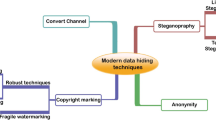Abstract
There is an increased emphasis on the use of digital techniques in all aspects of human life today. Broadcast radio and television, cellular phone services, consumer and entertainment electronics etc are increasingly using digital signal processing techniques to improve the quality of service. Transmission and storage of documentation and images pertaining to patient records cannot remain an exception to this global trend. Hence, patient records (text and image information) are increasingly stored and processed in digital form. Currently, text and image information, which constitute two separate pieces of data are handled as different files. Thus, there is a possibility of the text and message information, pertaining to different patients, being interchanged and thus mishandled. This can be avoided by merging text and image information in such a manner that the two can be separated without perceptible damage to information contained in either file. Digital watermarking techniques can be used to interleave patient information with medical images. In this work, we have employed digital watermarking along with strong cryptographic protocols and powerful error correcting codes. This reduces the probability of sensitive patient information falling into the wrong hands and ensures information integrity when it is conveyed over noisy channels.








Similar content being viewed by others
Explore related subjects
Discover the latest articles and news from researchers in related subjects, suggested using machine learning.References
Digital Imaging and Communications in Medicine (DICOM), National Electrical Manufacturers Association. Rosslyn, Virginia, USA, DICOM Committee, 2001.
Sergio, S. F., Marina, S. R., Ramon, A. M., Marcelo, S., Nivaldo, B., Gustavo, H. M. B. M., et al., “Managing medical images and clinical information” InCor’s experience. IEEE Trans. Inf. Technol. Biomed. 11 (1)17–24, 2007. 451.
Stefan, K., and Fabien, A. P. P., Information hiding techniques for steganography and digital watermarking. Artek House, Boston, 2000. ISBN: 1-58053-035-4.
Chris Shoemaker—Independent Study, Hidden bits: a survey of techniques for digital watermarking, EER-290 Prof Rudko Spring 2002.
Chung, Y. Y., and Wong, M. T., Implementation of digital watermarking system. Dig. Tech. Pap. IEEE Int. Conf. Consum. Electron., 214–215, 2003.
Giakoumaki, A., Pavlopoulos, S., and Koutsouris, D., Secure and efficient health data management through multiple watermarking on medical images. Med. Biol. Eng. Comput. 44 (8)619–631, 2006.
Gonzales, R. C., Woods, R. E., and Eddins, S. L., Digital image processing using MATLAB. Prentice Hall, Upper Saddle River, 2004.
Gonzales, R. C., and Woods, R. E., Digital image processing, 2nd ed. Prentice Hall, Upper Saddle River, 2001.
Elliott, M., and Schuette, B., “Digital image watermarking” ECE 533 image processing. University of Wisconsin-Madison, 21 Dec 2006.
Miyazaki, A., Digital watermarking protection technique for multimedia. Tech. Rep. IEICE. 102 (41)61–66, 2002.
Acharya, U. R., Deepthi, A., Bhat, P. S., and Niranjan, U. C., Compact storage of medical images with patient information. IEEE Trans. Inf. Technol. Biomed. 5 (4)320–323, 2001.
Acharya, U. R., Bhat, P. S., Kumar, S., and Min, L. C., Transmission and storage of medical images with patient information. Comput. Biol. Med. 33:303–310, 2003.
Nayak, J., Bhat, P. S., Acharya, U. R., and Kumar, M. S., Efficient storage and transmission of digital fundus images with patient information using reversible watermarking technique and error control codes. Springer, New York, 2008.
Announcing the Advanced Encryption Standard, Federal Information Processing Standards Publication 197, Nov 26, 2001 http://csrc.nist.gov/publications/fips/fips197/fips-197.pdf.
Daemen, J., and Rijmen, V., AES Proposal Rijndael, Version 2, 1999.
Wicker, S. B., and Bhargava, V. K., Reed–Solomon codes and their applications. IEEE Press, New York, 1994.
Shannon, C. E., A mathematical theory of communications, Bell System Technical Journal, pp. 379–423 (Part I), pp. 623–656 (Part 2), July 1948.
Moon, T. K., Error correction coding: mathematical methods and algorithms. Wiley, Hoboken, 2005.
Blahut, R. E., Algebraic codes for data transmission. Cambridge University Press, Cambridge, 2002.
Pretzel, O., Error correcting codes and finite fields. Clarendon, Oxford, 1992.
Lin, S., and Costello, D. J. Jr., Error control coding fundamentals and applications. Prentice Hall, Upper Saddle River, 2004.
Wicker, S. B., Error control coding for digital communication systems. Prentice Hall, Upper Saddle River, 1995.
McEliece, R. J., The theory of information and coding, II ed. Cambridge University Press, Cambridge, 2002.
Berrou, G., Glavieuc, A., and Thitmajshima, P., Near Shannon limit error-correcting coding: Turbo codes, in Proc. 1993, Int. Conf. Com., Geneva, Switzerland, May 1993, pp. 1064–1070.
Benedetto, S., Divsalar, D., Montorsi, G., and Pollara, F., A soft-input soft-output Maximum A Posteriori (MAP) module to decode parallel and serial concatenated codes, TDA progress report 42-127, November 15, 1996.
Rekh, S., Subharani, S., and Shanmugam, A., Optimal choice of interleaver for turbo codes. Acad. Open Internet J. 15, 2005.
Author information
Authors and Affiliations
Corresponding author
Rights and permissions
About this article
Cite this article
Nergui, M., Acharya, U.S., Acharya U, R. et al. Reliable and Robust Transmission and Storage Techniques for Medical Images with Patient Information. J Med Syst 34, 1129–1139 (2010). https://doi.org/10.1007/s10916-009-9332-3
Received:
Accepted:
Published:
Issue Date:
DOI: https://doi.org/10.1007/s10916-009-9332-3




